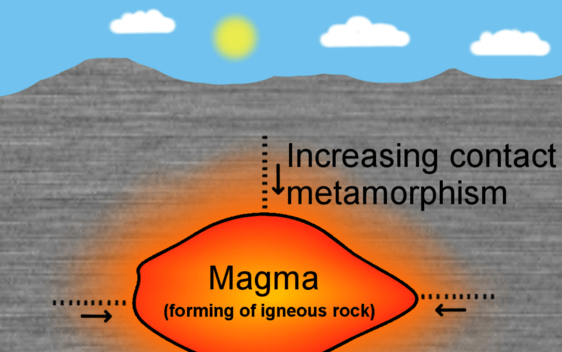Metamorphism is a part of the geological cycle or in other words rock cycle. Metamorphism changes the physical and chemical structure and properties of rocks. It could be classified as per the dominant agent responsible and the following is a brief list of it. Following are the types of metamorphism.
- Thermal Metamorphism
- Dynamic or Clastic Metamorphism
- Dynamo thermal Metamorphism
- Plutonic Metamorphism
- Metasomatism
- Geothermal Metamorphism
-
Thermal Metamorphism
Also known as heat metamorphism, it’s because high heat, that changed the properties of the rock.
Following are the subtypes of Thermal Metamorphism.
- Contact Metamorphism- This type of metamorphism occurs due to the continuous contact of stone with magma.
- Pyrometamorphism- This is also due to contact with magma but it’s more rapid than contact metamorphism.
- Optalic Metamorphism- This is because of the contact of magma with adjacent rocks.
- Pneumatolytic Metamorphism- This is also called injection metamorphism and is because of the influx of magma in the present bed of rock.
-
Dynamic or Clastic Metamorphism
In this type of Metamorphism, direct pressure is predominant. A few examples are beds of rock at the bottom of an ocean. In dynamic metamorphism, there is little or no change in the chemical structure of the rock, only physical changes are there.
-
Dynamo-thermal Metamorphism
Amongst all types of metamorphism, the study of this type of metamorphism is most important as it causes widespread regional metamorphic changes.
The predominant agents, that cause this are both, heat, and pressure to a substantial degree.This type of metamorphism may create new folds and result in the creation of new minerals.
-
Plutonic Metamorphism
In this type of change in the chemical and physical structure of rock, the agents that play the predominant role are uniform pressure and heat. It occurs deep inside the earth’s crust.
This type of metamorphism tends to change rocks into more dense minerals. One of the examples is the marble stone from the limestone.
-
Geothermal Metamorphism (Uniform pressure is predominant)
Usually, this type of metamorphism doesn’t change any properties in silicate stones. This type of metamorphism is found in the ocean bed.
Changes that could be observed in a Metamorphism yield Rocks
- Crystallization of calcareous sedimentary rocks (i.e. limestone)
- Recrystallization of igneous rocks
- Formation of drag folds, joints, etc.
- Formation of new minerals.
Relevant Readings-
Types of origin and nature of soil with perception of Geotechnical engineer
Objective and requirements of Soil Classification System
Most Useful Books For Geotechnical Engineering
Geotechnical Engineering Interview Questions
Other Resources-
Types of Metamorphism on Australian Museum site
